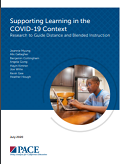
electronic resource
|
Supporting learning in the COVID-19 context : research to guide distance and blended instruction
Copies
0 Total copies, 0 Copies are in,
0 Copies are out.
Digital Link
Authors
Language
English
Series







